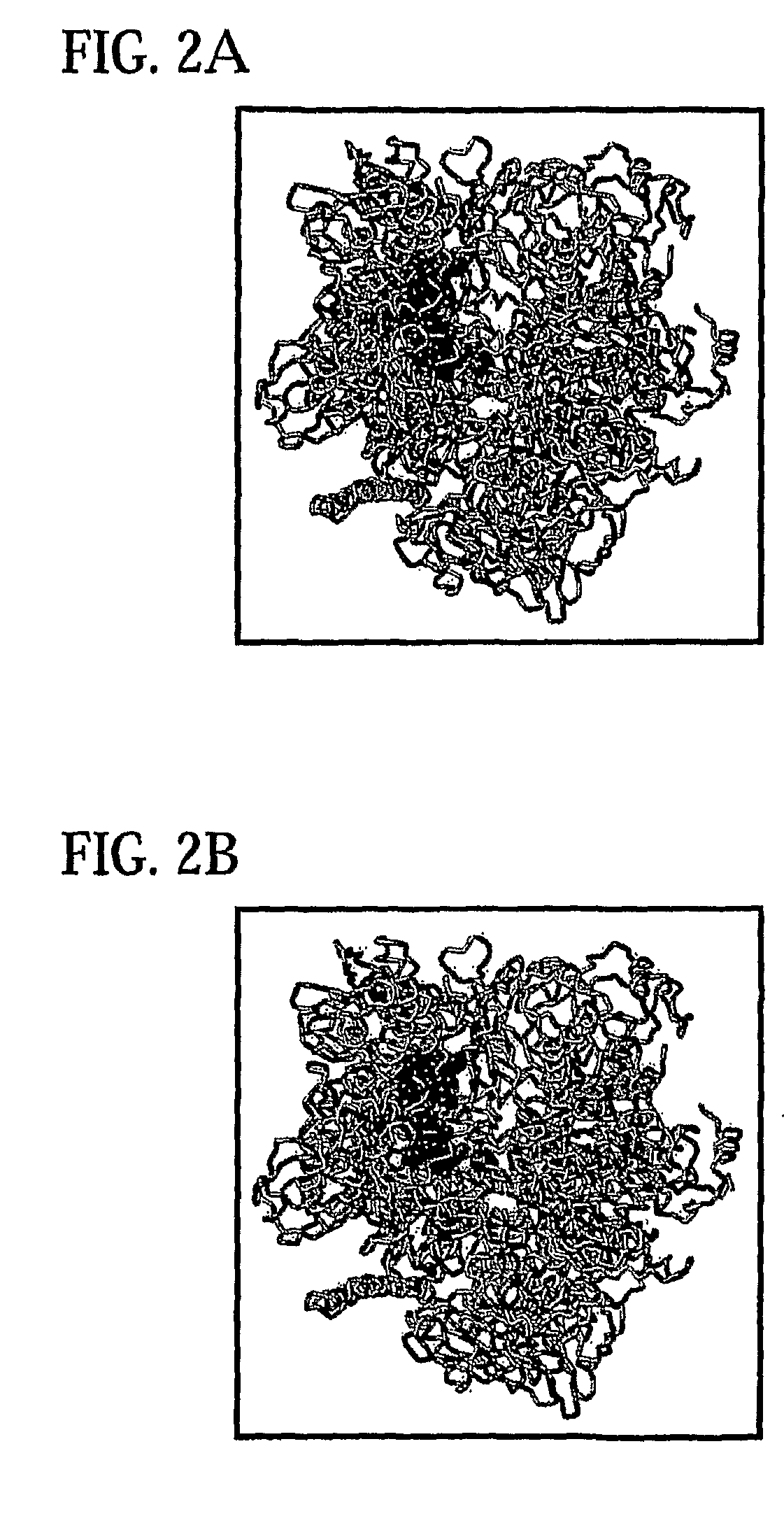Bipartite inhibitors of bacterial RNA polymerase
a technology of rifamycin and rna polymerase, which is applied in the direction of peptide sources, extracellular fluid disorders, metabolic disorders, etc., can solve the problems of threatening the clinical utility of rifamycin antibacterial agents, infections that pose a grave and growing threat to public health,
- Summary
- Abstract
- Description
- Claims
- Application Information
AI Technical Summary
Benefits of technology
Problems solved by technology
Method used
Image
Examples
example 1
Synthesis of {Rifamycin SV}—{CH2C(O)NH(CH2)nNHC(O)CH2S(CH2)3C(NH2+)}-{[Lys5]MccJ25} (“Rifamicrocin 1-n”; n=6, 8, 10, or 12)
1.1: {Rifamycin SV}—CH2C(O)NH(CH2)nNH2 (n=6, 8, 10, or 12)
[0098]To rifamycin B (8 mg, 10.1 μmol; Pharmeks) in 150 μl anhydrous tetrahydrofuran, was added dicylohexylcarbodiimide (8 mg; 38.8 μmol; Aldrich) in 50 μl anhydrous tetrahydrofuran, the reaction mixture was incubated 15 min at 25° C., and 2 ml diethyl ether was added. The resulting precipitate was dissolved in 100 μl methanol containing H2N(CH2)nNH2 (10 mg; 80 μmol; Aldrich), where n=6, 8, 10, or 12, and the reaction mixture was incubated for 30 min at 25° C. The product was purified by thin-layer chromatography on silica gel in 2:1 (v / v) chloroform:ethanol, eluted from chromatographic plates in methanol, and dried in vacuo. Yield: 2.6 mg (3 μmol, 30% yield).
1.2: {Rifamycin SV}—CH2C(O)NH(CH2)nNHC(O)CH2Br (n=6, 8, 10, or 12)
[0099]To {rifamycin SV}—CH2C(O)NH(CH2)nNH2, where n=6, 8, 10, or 12 (2.6 mg; 3 μmo...
example 2
Synthesis of {Rifamycin SV}—{CH2C(O)NH(CH2)n(O)(CH2)2(C2N3)(CH2)4C(O)}-{[Lys5]MccJ25} (“Rifamicrocin 2-n”; n=10)
2.1: Ethyl 5-Azidovalerate
[0104]Ethyl 5-bromovalerate (2.1 g; 10 mmol; Aldrich) was added to a stirred suspension of sodium azide (1.3 g, 20 mmol; Fisher) in 5 ml dimethylformamide and 5 ml water, and the reaction mixture was heated 12 h at 80° Cs. The reaction was partitioned between diethyl ether (100 ml) and water (100 ml), and the resulting organic layer was washed with water (100 ml) and brine (100 ml), dried over sodium sulfate, and dried in vacuo. Yield: 1.6 g (9.3 mmol, 95% yield).
2.2: 5-Azidovaleric Acid
[0105]To ethyl 5-azidovalerate (1.6 g; 10 mmol; Example 2.1) in 5 ml-dimethylformamide, was added lithium hydroxide (1.0 g; 20 mmol; Fisher) in 5 ml water, and the reaction mixture was stirred 12 h at 25° C. The reaction mixture was adjusted to pH ˜4 by addition of 1 N HCl and was extracted with 100 ml diethyl ether. The resulting organic layer was washed with wate...
example 3
Measurement of Effects of Rifamicrocins on Transcription
3.1: RNAP
[0110]RNAP was prepared as described in Niu, et al. (1996) Cell 87, 1123-1134. [Asn516]β-RNAP, a strongly rifamycin-resistant RNAP derivative (see Jin, et al. (1988) J. Mol. Biol. 202, 45-58) was prepared in the same manner, except that plasmid pRL706-516N was used in place of plasmid pREII-NHα. [Plasmid pRL706-516N, which encodes C-terminally hexahistidine tagged [Asn516]β, was constructed from plasmid pRL706 (Severinov, et al. (1997) J. Biol. Chem. 272, 24137-24140) by use of site-directed mutagenesis (QuikChange Site-Directed Mutagenesis Kit; Stratagene).]
3.2: Transcription Assays
[0111]RNAP or [Asn516]β-RNAP (3 fmol; Example 3.1) and each test compound (250 fmol-100 pmol) were pre-equilibrated 30 min at 37° C. in 15 μl buffer A (50 mM Tris-HCl, pH 8.0, 100 mM KCl, 10 mM MgCl2, 1 mM dithiothreitol, 10 ug / ml bovine serum albumin, and 5% glycerol). To the reaction mixture, was added 1 μl of 1 μM DNA fragment comprising...
PUM
| Property | Measurement | Unit |
|---|---|---|
| molecular mass | aaaaa | aaaaa |
| molecular mass | aaaaa | aaaaa |
| pH | aaaaa | aaaaa |
Abstract
Description
Claims
Application Information
 Login to View More
Login to View More - R&D
- Intellectual Property
- Life Sciences
- Materials
- Tech Scout
- Unparalleled Data Quality
- Higher Quality Content
- 60% Fewer Hallucinations
Browse by: Latest US Patents, China's latest patents, Technical Efficacy Thesaurus, Application Domain, Technology Topic, Popular Technical Reports.
© 2025 PatSnap. All rights reserved.Legal|Privacy policy|Modern Slavery Act Transparency Statement|Sitemap|About US| Contact US: help@patsnap.com



